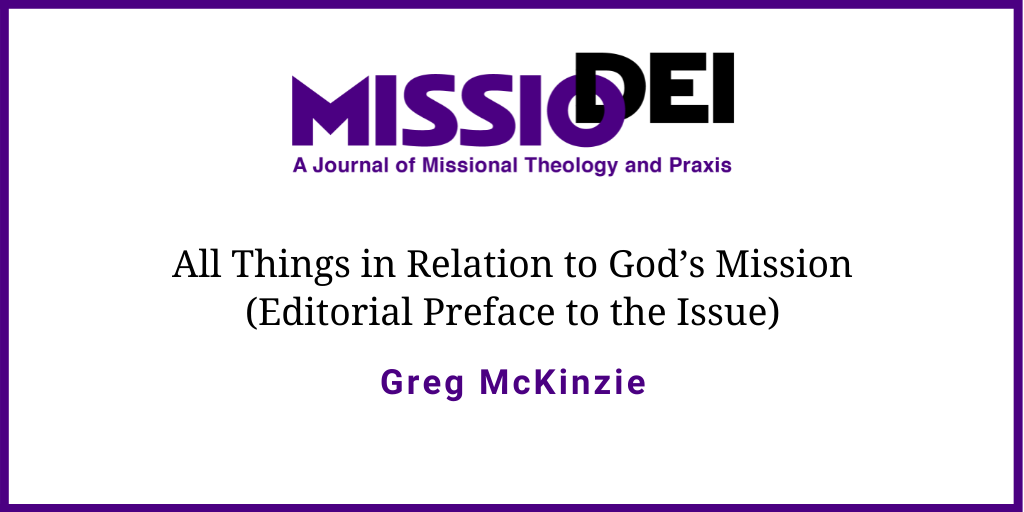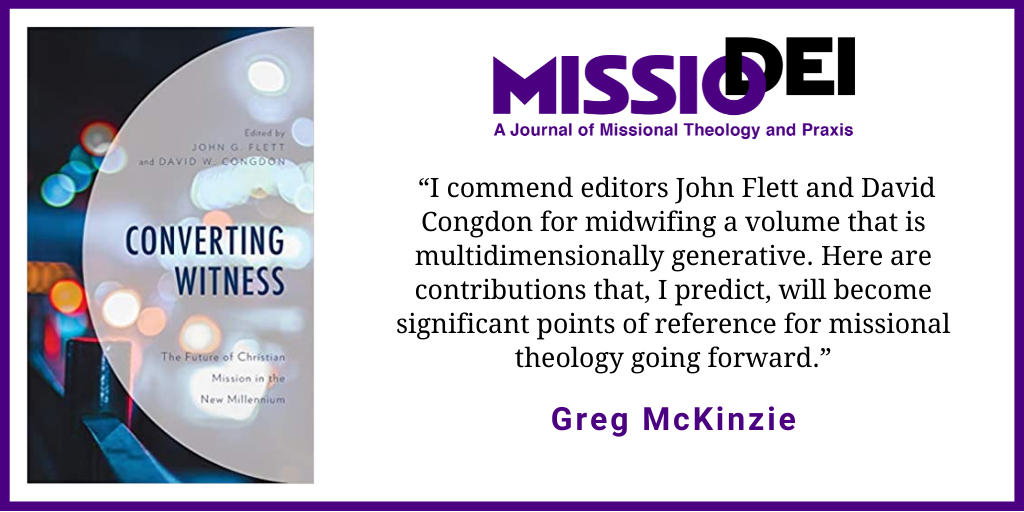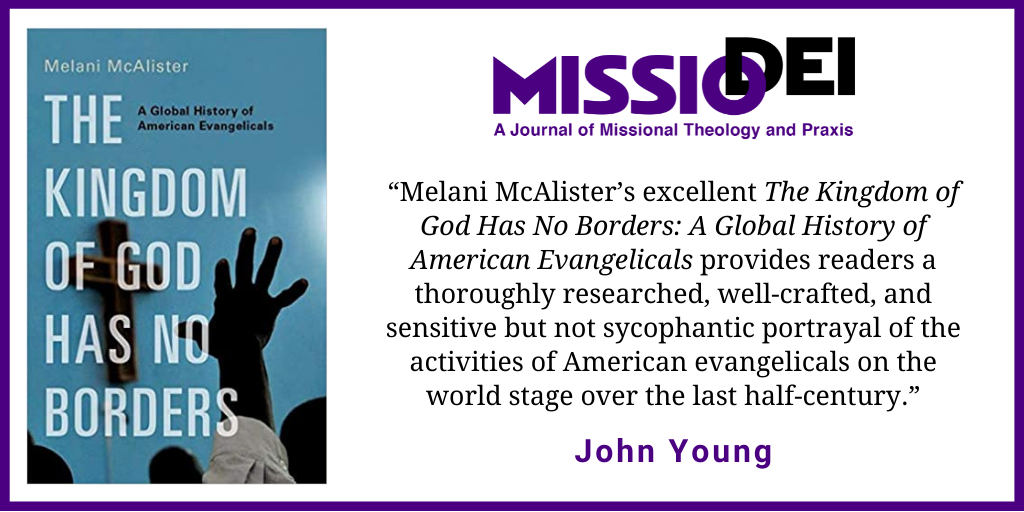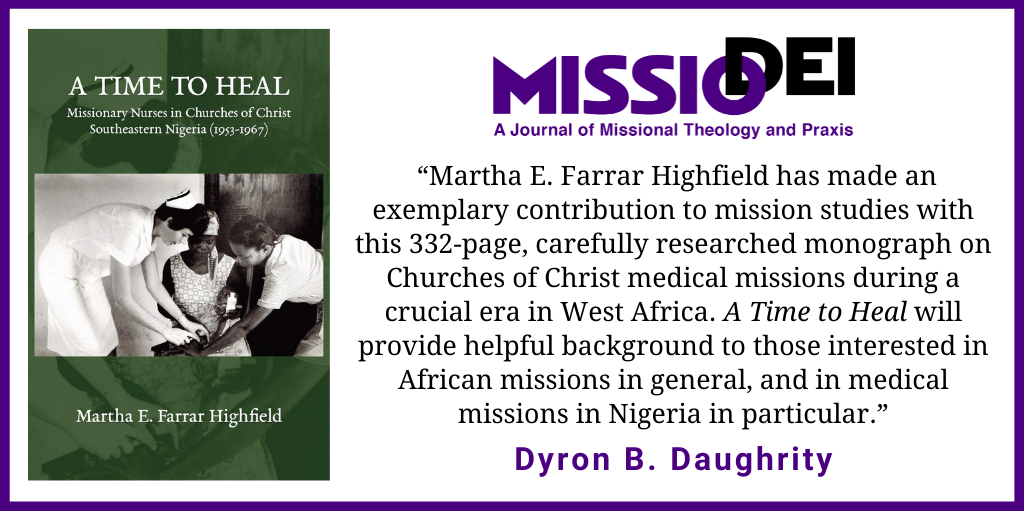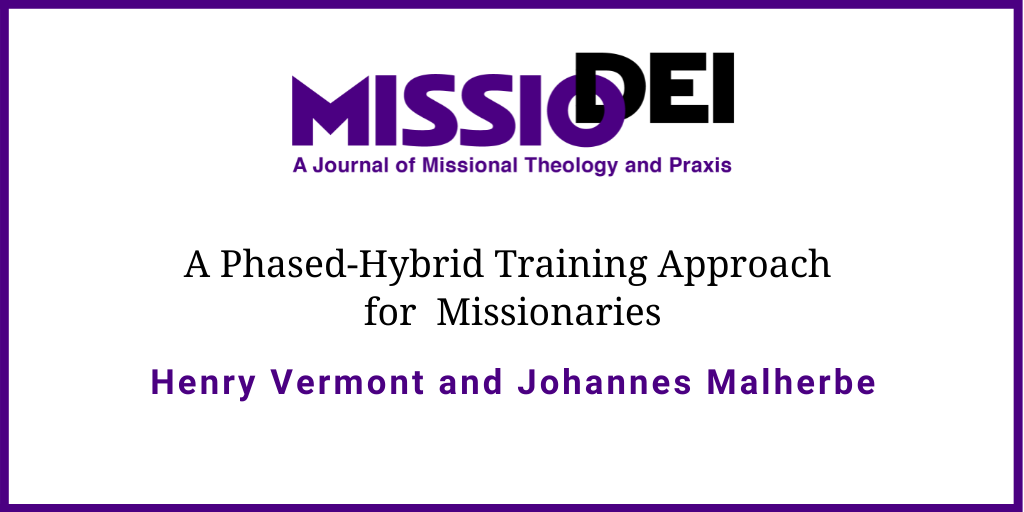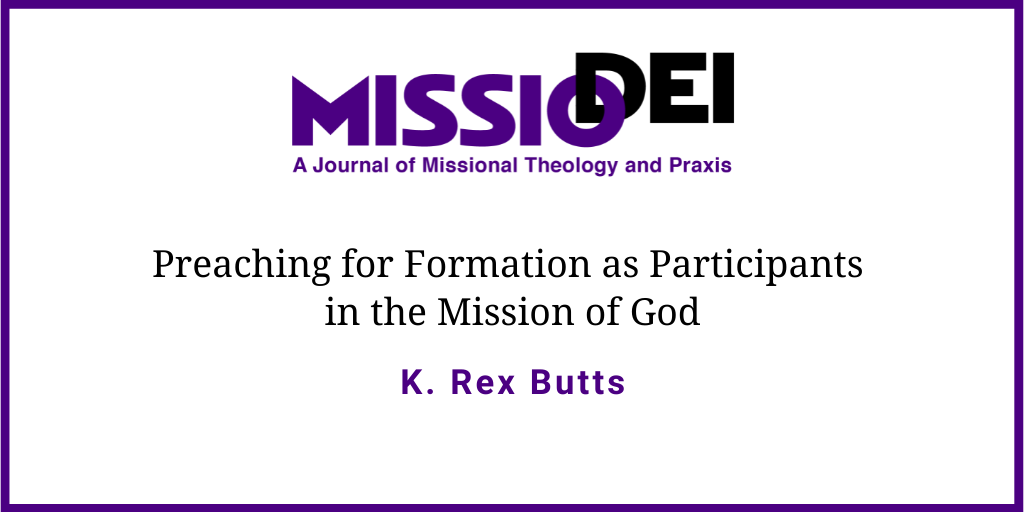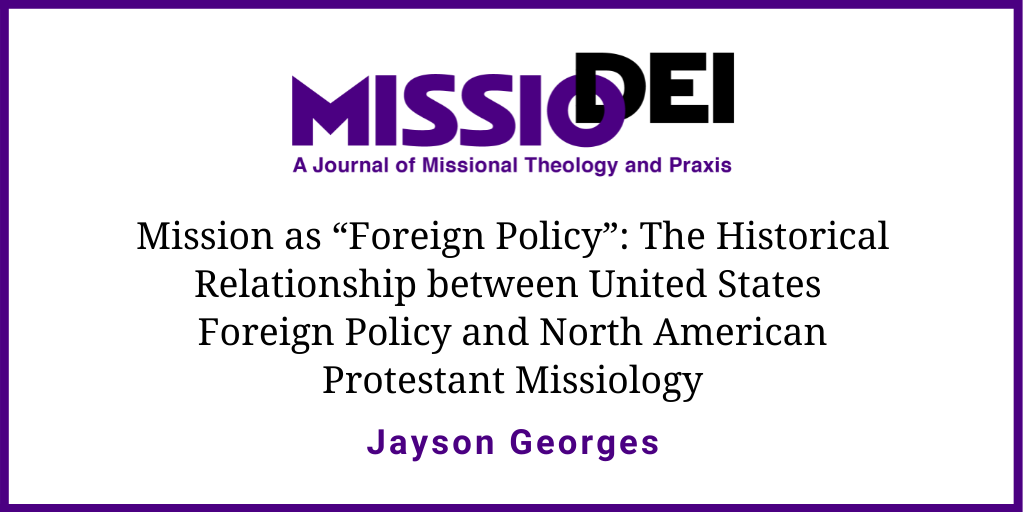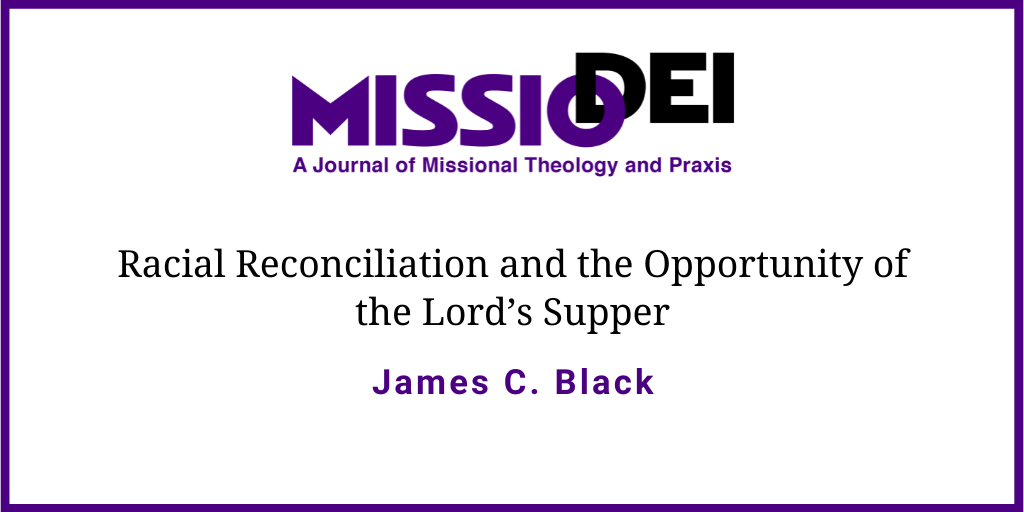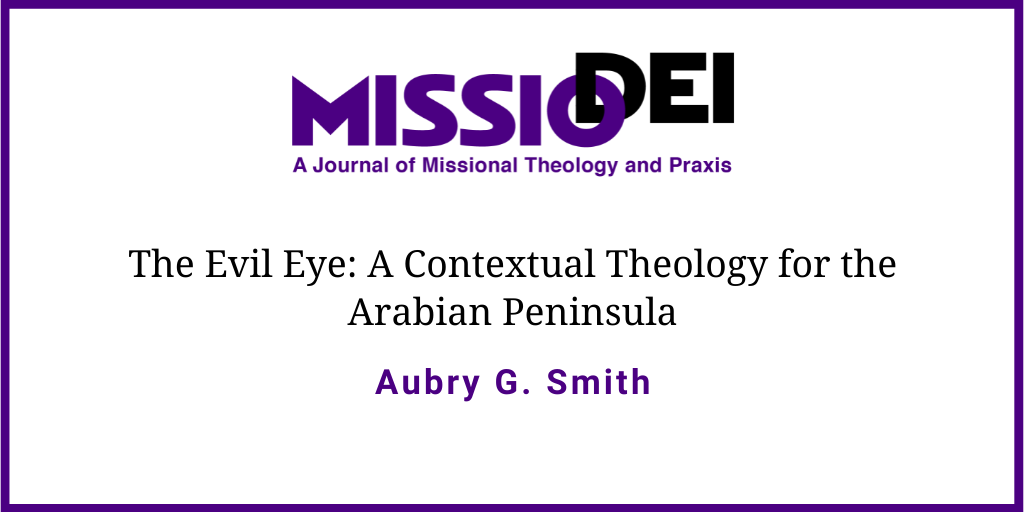
The Evil Eye belief and practice complex is widespread throughout the world, yet there are no contextual theologies effectively dealing with this complex in the Middle East. This article explores the beliefs and practices related to the Evil Eye, surveys biblical references to the Evil Eye often obscured by English translations, and finally, offers a contextual theology of the Evil Eye. The article focuses in particular on the Arabian Peninsula as a case study in contextualization.
The Evil Eye is a widespread complex of beliefs and practices found throughout the Mediterranean, the Middle East, India, North Africa, and parts of Latin America with colonial ties to Spain or Portugal. Originating thousands of years ago, the conviction that an envious person casts a curse through the eyes has endured steadily through vast historical and cultural shifts. Fear of the Evil Eye results in various folk practices to ward it off or cure the afflicted. For Arabs of the Arabian Peninsula, fear of cursing via the Evil Eye or malicious spells permeates thoughts, behaviors, and relationships.
The Islamic community confirms the narrative of the Evil Eye and also offers protective or curative treatments based on both the Qur’an and the Hadith. However, Middle Eastern Christians have not yet developed a contextual theology regarding the Evil Eye, despite the prevalence of the belief system. This void in resources also affects missionaries working with both Muslims and believers from a Muslim background (BMBs). Currently, few resources aid the missionary in understanding the Evil Eye belief.
However, a contextual theology of the Evil Eye is vital for the flourishing of new believers on the Arabian Peninsula. In the absence of a biblical framework, BMBs may rely on unbiblical protections or cures. Conversion to Christianity will not instantly disintegrate this profound belief; the Evil Eye belief complex weaves through the emotional, physical, spiritual, and relational components of Arab lives. Thus, if missionaries cannot help BMBs understand the Evil Eye from a biblical perspective, new believers may feel vulnerable to danger and fall back on Islamic practices for protection and treatment. This oversight in a contextual theology of the Evil Eye may increase the risk of BMBs returning to Islam altogether. Conversely, dealing effectively with the Evil Eye belief may enable BMBs to live victoriously in the freedom Christ offers.
This paper will survey the Evil Eye belief system and analyze its accompanying behaviors and practices on the Arabian Peninsula. It will then review biblical evidence relevant to the belief in the Evil Eye in both the Old and New Testaments. Finally, it offers a contextual theology of the Evil Eye, with specific applications for the developing church of the Arabian Peninsula and the missionaries who disciple BMBs.
The Evil Eye Belief and Practice Complex
The Threat of the Evil Eye
The Evil Eye is a force emitted like a light through the eye, causing harm to those it befalls. A person casts the Evil Eye—intentionally or accidentally—whenever they are envious of something that another possesses. The more beautiful or desirable the object or person is, the more likely they are to attract the dangers of the Evil Eye. Allan Berger observes that the most vulnerable to the Evil Eye are “infants, young children, pregnant and lactating women, fruit-bearing trees, and prized livestock.” The wealthy or those who have suddenly experienced great fortune are also particularly vulnerable to the curse. In general, the curse threatens fruitfulness and blessing. Many cultures believe that certain individuals have a hereditary disposition for casting the Evil Eye. Those born with this disposition are often considered the most dangerous possessors of the Evil Eye’s power. Those who have eye defects, blue or green eyes, barrenness, or disabilities are the most likely bearers of the Eye.
Bruce Malina notes that concepts of envy and the Evil Eye especially arise in collectivistic cultures which view all goods in limited supply. These goods include honor, parental love, friendship, money, houses, cars, and children. Because these goods are always in limited supply, one person’s gain always entails another’s loss. Drawing attention through compliments or staring is interpreted as cursing through drawing the Evil Eye. Generosity is a high social value and collectivistic cultures practice it publicly, as it proves to society that a person is not casting the Evil Eye and is therefore not a threat. Those who are generous have a “good eye” and are not a societal threat.
For Arabs of the Arabian Peninsula, the prevalence of black magic used for cursing compounds the fear of the Evil Eye. The use of black magic centers in the city of Bahla, Oman. Arabs from all over the Middle East will either travel to Bahla to obtain curses or will avoid traveling to Oman for fear of being cursed. These curses are often written on a small piece of paper, hidden on a person’s property or in their possessions, or dissolved secretly into a liquid that the cursed one drinks. Danger from cursing either by the Evil Eye or by black magic lurks everywhere for Arabs on the Arabian Peninsula.
Symptoms of the Evil Eye
Many common physical symptoms alert these cultures to the curse of the Evil Eye. Berger notes that “headache, gastrointestinal symptoms, fevers, chills, lassitude, impotence, nocturnal emissions, convulsions, and . . . death” are all symptoms of the Evil Eye befalling a person. Aref Abu-Rabia adds to this list menstrual problems, difficulties in pregnancy or childbirth, reduced milk supply in a lactating mother, or a baby refusing to nurse. The plethora of potential indications of cursing serves to intensify the ubiquitous peril of the Eye. The Evil Eye is a profound cultural narrative for the experience of unexplained or sudden misfortune. Car wrecks or other accidents (mechanical failure of machinery or household appliances) and even death are all frequently attributed to the curse of the Evil Eye.
Apotropaic Magic and Treatment
With the danger of the Evil Eye lurking behind every misfortune and physical symptom, people frequently utilize apotropaic magic to prevent ailments from the Evil Eye. One example is the well-known Greek practice of spitting as a method of protection from the Evil Eye. Possession of the Evil Eye is often associated with defilement and impurity, so fumigation by burning bakhoor (incense) is a common Middle Eastern purification practice.
On the Arabian Peninsula, amulets bearing a blue eye called nazar, blue beads, or the “Hand of Fatima” (a hand bearing a blue eye) are especially prevalent. The Arabic phrases mashallah (God has willed it) or bismillah (in the name of Allah) are verbal exclamations used to ward off the Evil Eye from an admired object or person. Cars, houses, buildings, or other valuable objects often bear the phrase mashallah as a means of warding off the Evil Eye drawn through envy. In addition to placing a mashallah sticker on the back of a car, Arabs will also play Qur’anic chants in the vehicle exclusively for a period of time after purchase for protection against the Eye. Parents protect babies by administering black kohl around the eyes like eyeliner, and tying black strings around babies’ wrists for protection. Male infants are sometimes dressed as girls to “confuse” the Evil Eye, as they are particularly vulnerable to drawing envy from others. Parents and grandparents will describe the new child in ugly terms to shield them from the Eye.
Treatments for the Evil Eye include fumigation with incense, incantations, purifying baths, drinking Qur’anic verses written on paper and dissolved in water, spitting on the afflicted person, or even transferring the Evil Eye to the healer. These modern practices have ancient roots, however. The text of Scripture demonstrates belief in the Evil Eye, as well as the sociological behaviors associated with that belief.
The Evil Eye in Scripture
Modern Western theologians have overlooked the Evil Eye due to cultural presuppositions and because English translations obfuscate the presence of the Evil Eye throughout Scripture. The following section briefly surveys Scripture relevant to the Evil Eye belief.
Old Testament Evidence
Genesis Patriarchal Narratives
Envy is a dominant theme in the patriarchal narratives, often resulting in violence, misfortune, or death. Envy permeates the story of Cain and Abel, which leads Cain to kill Abel (Gen 4:1–12). There may even be an etymological association with Cain’s name and the Hebrew root word for envy. The rabbinical literature attributes the Evil Eye to Cain.
Jews have long interpreted the story of Sarai and Hagar in Genesis 16 through the lens of the Evil Eye. It is well-known among many cultures that one of the most dangerous possessors of the Evil Eye is a barren old woman, and pregnant women and their babies are among the most vulnerable. The NIV obscures the references to the eyes by translating the phrase in 16:4 as “she [Hagar] began to despise her mistress.” However, a better translation might be, “her mistress was despised in her eyes,” a passive phrase indicating that Hagar was not merely despising but also cursing Sarai with her eyes. That Sarai immediately connects this with her suffering (v. 5) suggests that Hagar’s eyes affected Sarai’s well-being. To keep Hagar in her lowly position, Sarai accuses Hagar of casting the Evil Eye on Sarai. Jewish interpreters often argued that this accusation attempts to cover up the fact that Sarai is the one casting the Evil Eye on Hagar in this passage. However, God, who sees Hagar, blesses her and her offspring rather than cursing them (vv. 9–12). The angel commands Hagar to go back to the source of cursing and mistreatment, but God promises to bless and protect her.
Deuteronomy 15:9; 28:54, 56
The concept of the Evil Eye is present throughout Deuteronomy, though English translations fail to reflect this. In Deut 15:7–11, God commands the Israelites to give generously to the poor, even when the year for canceling debts is upon them, and they might not receive back what they have loaned. A closer translation of a phrase in v. 9 is, “lest your eye be evil (ayin ra’a) against the poor.” The Evil Eye is often associated with stinginess; the concept of “limited good” creates inner greed, as those who have what is desirable possess it at the expense of those who lack. Thus, generosity is here encouraged as a countermeasure against an Evil Eye that reveals a greedy heart.
Similarly, a phrase in the NIV translation of Deut 28:54 reads, “even the most gentle and sensitive man will have no compassion on his own brother” (emphasis added). However, a better translation of the Hebrew text states that this man’s “eye shall be evil (ayn yar’a) toward his brother.” The writer uses the same phrase in reference to a woman in v. 56. The author warns the Israelites here of God’s curses coming upon the Israelites for disobedience to the law. The suffering brought on by the curses will be so tremendous that even the most compassionate men and women cannibalize their loved ones. In the reality of extremely limited resources, the Evil Eye acts as a representative of greed and stinginess harbored in the heart, ultimately causing death.
1 Samuel 18:7–10
In this passage, the Israelites praise David and compare him with Saul in their song: “Saul has slain his thousands, and David his tens of thousands.” In a society of limited good, the rising of David’s honor requires the demise of Saul’s honor, and Saul’s response is anger and malicious envy. The NIV translates verse 9: “From that time on Saul kept a close eye on David.” However, the KJV renders it, “Saul eyed David from that day forward” (emphasis added). The KJV better maintains this relationship to envy, the eye, and harm to others expressed in the Hebrew text. Interestingly, though Saul is casting the Evil Eye here, God sends an evil spirit that torments Saul and causes suffering to him rather than David, who escapes harm (v. 10–11). Saul’s “eyeing” of David is not successful because “the Lord was with David but had departed from Saul” (v. 12).
Proverbs 22:9; 23:6–8; 28:22
The book of Proverbs associates the eye with either greed or generosity in the heart. The KJV translation maintains the reference to the effective eye, translating 22:9 as, “He that hath a bountiful eye shall be blessed; for he giveth of his bread to the poor.” This proverb correlates the ideals of generosity with the eye, as well as with God’s blessing. God blesses those with a good and generous eye.
Conversely, Prov 23:6–8 says, “Eat thou not the bread of him that hath an evil eye, neither desire thou his dainty meats. For as he thinketh in his heart, so is he. Eat and drink, saith he to thee; but his heart is not with thee. The morsel which thou hast eaten shalt thou vomit up, and lose thy sweet words.” This proverb shows the connection between the Evil Eye and a greedy, duplicitous heart. The Sage warns the reader against relational liaisons with one who has the Evil Eye, who will cause harm to those in his proximity.
Proverbs 28:22 warns, “He that hasteth to be rich hath an evil eye, and considereth not that poverty shall come upon him.” Here, the curse of the Evil Eye is turned inward upon its possessor, ultimately causing him poverty rather than the wealth he desired. This proverb is an ominous admonishment against the dangers of the Evil Eye for its possessor.
New Testament Evidence
Matthew 6; cf. Luke 11:33–34
Jesus addresses key sin issues behind the Evil Eye in Matt 6:19–24. The chapter deals with public displays of piety—generosity to the poor (6:1–4), prayer (6:5–15), and fasting (6:16–18). These instructions are followed by teachings on worldly possessions and worry about those possessions (6:19–34). The goal of public piety is that others view the subject as generous, pious, and righteous. However, these public displays did not always extend down into the heart, particularly for the Pharisees. Jesus observes the hypocrisy of it and urges his followers to give to the poor in secret, pray in closets, and groom themselves properly while fasting. These commands are not intended to make faith a private matter, out of the public eye entirely, but to encourage Christians to do pious works for the Lord rather than for status and reputation gains. He calls them to be truly generous people who care about the poor, rather than acting generously to be perceived as generous, elevating their social profile.
Jesus then describes the eye as the “lamp of the body” (6:22). In cultures that believe in the Evil Eye, the eye is not a passive recipient of light as modern science might teach. Instead, it is an active force that emits light as a lamp would, affecting the external world with its light. Jesus connects the state of the heart to the eyes in this passage, thus arguing that if a person’s eyes are “healthy” (Greek: haplous; literally, “simple, single, or whole”), the whole body will be full of light. However, if the eyes are “unhealthy” (Gk poneros, literally “evil”), the person’s body will be full of darkness. Thus, those who store up treasure in heaven are presumably those with true devotion to God and true generosity towards others, not merely feigned or public displays.
Finally, Jesus’s disciples are not to worry about worldly possessions but to trust God to provide for their daily needs. The focus in a believer’s life is not to be on worldly concerns or even the self but centered wholly on God. The believer need not fear another casting a curse on his possessions because God keeps the believer’s treasures. Contentment and peace characterize Jesus’s followers rather than envy and worry over possessions.
Matthew 20:1–16
Jesus also refers to the Evil Eye in his parable of the workers in the vineyard. In this parable, the landowner hires workers for his vineyard at various times throughout the day. At the end of the day, the landowner pays all workers—regardless of hours worked—a denarius. When the full-day laborers complain, the landowner remarks, “Is it not lawful for me to do what I will with mine own? Is thine eye evil, because I am good?” (20:15). The envy and Evil Eye of the workers is contrasted here with the generosity and good eye of the landowner. The passage’s meaning is that God’s grace extends equally to both Jew and Gentile because he is generous. It is wrong for the Jews, those who came first, to develop an Evil Eye over God’s vast mercy. This passage obliterates the concept of “limited good” for salvation. The gain of the Gentiles does not demand loss for the Jews. God’s generosity is capacious for all.
Mark 7:1–8:26
In Mark 7, Jesus redefines defilement for his Jewish audience: defilement arises from within rather than externally. The Pharisees have asked him why his disciples do not wash for purification before eating, per their oral traditions. Jesus reprimands the Pharisees’ focus on outer purity while retaining inner defilement. He says, “For from within, out of the heart of men, proceed evil thoughts, adulteries, fornications, murders, thefts, covetousness, wickedness, deceit, lasciviousness, an evil eye, blasphemy, pride, foolishness. All these evil things come from within, and defile the man” (7:21–23, emphasis added). Ritual washings that the Pharisees hold so dear do not cleanse these defilements. While most cultures fear the Evil Eye as an external force, Jesus here emphasizes its inner presence in a person that causes defilement.
Galatians
In his epistle to the Galatians, Paul incorporates Evil Eye practices and beliefs as part of his argument. Paul writes in 3:1, “You foolish Galatians! Who has bewitched (ebaskenon) you?” (NIV). The Greek root of ebaskenon is baskaino, and while this verb often gets translated as “bewitched” into English, baskaino is the Greek term for cursing someone with the Evil Eye. Paul here accuses the Galatian Judaizers of casting the Evil Eye on the Galatian Church. Paul’s accusation is likely a counter-accusation to the Judaizers, who may have accused Paul of casting the Evil Eye on the Galatian Church.
John Elliott observes evidence of the Evil Eye belief complex throughout the epistle to the Galatians, often overlooked by Western biblical commentaries. First, Paul recounts that the Galatians did not spit (exeptousate) due to his illness when they met him (4:13–14). Most English versions translate this verb as “reject” or “scorn,” which obscures the cultural reference to the apotropaic practice of spitting to ward off the Evil Eye. Paul further remarks that the Galatians would have plucked their own eyes out and given them to Paul if it had been possible (4:15), indicating that his illness may have affected his eyes. So while Paul’s adversaries accused him of bearing the Evil Eye—likely because of his unhealthy eyes—Paul is countering that accusation by appealing to the Galatians’ initial instinct of welcoming Paul and not treating him as a threat of the Evil Eye curse. Elliott also notes that Paul frequently refers to the Galatians as children (3:23–29; 4:1–7, 19)—one of the most vulnerable groups to the dangers of the Evil Eye. In addition, envy is a major theme related to Paul’s accusers (4:17–18; 5:20, 21, 26), as is cursing (1:8–9; 3:1, 10, 13).
Contextual Theology and Missiological Applications
Having surveyed the biblical texts relevant to the Evil Eye belief complex, I consider the Evil Eye from within the framework of systematic theology, particularly from within the categories of theology proper, hamartiology, Christology, and ecclesiology. Such systematization may aid the Western missionary or theologian grappling with the concept of the Evil Eye. This section also explores contextualized missiological applications for the Arabian Peninsula, to aid the missionary discipling a BMB.
Theology Proper: God’s Good Eye
God’s eye is a frequent motif in Scripture. God’s eye is linked with judgment as people do “evil in the eyes of the Lord” (Deut 4: 25, 12:25, 28, 17:2, 24:4; Judg 3:7). He bestows favor and blessing for those who do right in God’s eyes (Gen 6:8, Deut 21:9, 1 Kgs 15:11, 2 Chron 16:9, Ps 53:2). God’s eye is a force for care over the Promised Land (Deut 11:12). God’s presence protects Hagar, Joseph, and David from the Evil Eye of those who envy them. His “seeing” of the victims and his protective eye are frequent themes in the writings of David (Ps 10:14, 14:2, 33:18, 34:15, 35:22) and the story of Hagar (Gen 16:13–14). Jesus emphasizes God’s generosity in the New Testament towards both Jew and Gentile in salvation.
The Old Testament describes God as a “jealous God” (Exod 20:5; Deut 4:24, 5:9, 6:15, 32:16; Josh 24:19; 1 Kgs 14:22; Ps 78:58, 79:5; Ezek 16:38, 23:25, 36:6; Joel 2:18; Nah 1:2; Zeph 1:18, 3:8; Zech 1:14, 8:2). Here we distinguish between envy and jealousy, which are often used as synonyms in colloquial English. Jealousy is the emotion felt for the imminent loss of something one already possesses. For instance, a husband might feel jealousy over his wife if he fears losing her to another man. On the other hand, envy is the emotion felt when someone else possesses something that one desires. Malicious resentment and ill will accompany envy. It is in this sense that the Bible issues the commandment against coveting (Exod 20:17). God’s people are not to envy what their neighbors have. God is therefore not envious but is jealous for the worship of his people.
The Islamic Allah is, in contrast to the biblical God, capricious and withholding. Muslims of the Arabian Peninsula live in constant fear of death, as they acknowledge that even Muhammad was not guaranteed Paradise for his good works. Muslims invoke the name of Allah as a source of protection from the Evil Eye, yet Arabs remain in constant fear and danger from the Eye. Discipleship of a believer from such a background must be grounded in the alignment of the concept of Allah to the true biblical God, who is generous, immanent, and compassionate.
Hamartiology: Envy as a Deadly Sin
Envy is an important concept to consider within the theological notions of sin. In Scripture, envy is described as an inner vice that “rots the bones” (Prov 14:30) and is potentially more dangerous than anger and wrath (Prov 27:4). Envy frequently appears in lists of sins (Mark 7:22; Rom 1:29; Gal 5:21; 1 Tim 6:4; 1 Pet 2:1) and characterizes those outside of Christ’s redeeming and transforming work. The Genesis patriarchal narratives display the disastrous results of envy and its ability to destroy relationships, particularly among family members. Jesus addresses this inner darkness of envy and greed (Matt 6:19-24; Luke 11:33-34), and James links envy with selfish ambition, evil, and chaos (Jas 3:14). Casting the Evil Eye on others and cultivating a stingy heart may result in a curse on the self (1 Sam 18:7–10; Prov 28:22).
Envy is a powerful vice in the Arabian Peninsula, cultivated by millennia of nomadic life searching for limited resources in a hostile desert. Envy may also be accompanied by hoarding and an overdeveloped desire for wealth and honor. While Western missionaries may derogate the eye’s ability to cause destruction, overlooking the dangers of envy would be detrimental to those they disciple. As honor and status are the most coveted prize in the Arab world, Jesus’s example of generosity and humility is of utmost importance. His ultimate honor comes through bearing the shame of the world. Christians ought to imitate his humility, generosity, and valuing others above self (Phil 2:1–18). Their lives are to be for God’s glory and honor alone, in the power of the Holy Spirit. This provides the freedom for believers to give generously, to bless rather than curse, and to live with contentment at their very core.
Christology: Christ who Bore the Curse
Arabs in the Arabian Peninsula live in great fear of curses, from both the Evil Eye and black magic. God’s plan to bring the world blessing (Gen 12:1–3) culminates in the person of Christ, who bore the curse of humanity on the cross (Gal 3:13; Col 2:13–15). He has broken the power of the curse over believers and will one day do away with all curses (Rev 22:3). Those who do not submit to Christ or who preach a gospel other than Christ are ultimately those who will be cursed (Matt 25:41; John 7:49; 1 Cor 16:22; Gal 1:8–9, 3:10; Heb 6:8). Jesus is the source of blessing for the downtrodden and outcast (Matt 5:3–11), for children (Mark 10:16), and his followers (Luke 24:50; John 20:29; Rom 4:8; 10:12; Eph 1:3).
While there is evidence that Ancient Israelites used amulets and incantations against the Evil Eye and other dangers, the Bible does not promote the use of magical elements to ward off the Evil Eye. God forbids his people to use magic, spells, and incantations (Deut 18:11–12; Exod 22:18; Ezek 13:18, 20; Rev 9:21, 18:23). Arab believers, as they increase their trust in Christ, should ultimately reject the usage of magical elements such as amulets and spells as forms of protection against evil. Additionally, they could replace such practices with biblical disciplines, such as prayer. In Matthew 6, Jesus taught his disciples to pray for God to deliver them from evil. This prayer, however, should be carefully taught as a model for prayer and not as a magical incantation to replace mashallah. Crosses should not replace nazar as amulets for protection, as some churches may find tempting.
Additionally, Paul teaches the Ephesians about putting on the armor of God, using the Word of God, and praying in the Spirit to stand against evil (Eph. 6:10–20). Protection from evil for the Christian comes from God by grace, not through amulets and incantations. Symbols such as the cross may be powerful reminders of protection in Christ. BMBs, however, need to carefully decide whether to use them, particularly if there is a risk of using the symbol as an amulet instead of a reminder.
In addition, new believers will need to be grounded in a theology of suffering and evil. While they may have trusted amulets or uttered phrases to prevent suffering, those in Christ are not immune to the realities of suffering in their lives. Christ is not an amulet, and prayer is not a magic spell—such understandings will lead to syncretistic practices. Believers follow a crucified and risen Savior, and they carry their crosses with him. They trust in his purposes, and his sovereignty must grow over time through suffering, as well as a sense of participation in the sufferings of Christ (Phil 3:10). The Evil Eye can no longer be the primary narrative of suffering and misfortune. Instead, God’s providence and purposeful sovereignty over the painful realities of life can help a Christian grow in trust and away from fear.
Ecclesiology: The Church as a People of Blessing
The Church should embody freedom from the Evil Eye and the ability to bless in Christ’s name. In contrast to the greed and closed-handedness of those who might bear the Evil Eye, Christians should be generous to those in need. Believers must cultivate true inner generosity and contentment through the Holy Spirit, in contrast with the temptation to outwardly do that which may gain a person a reputation for generosity. The growth of virtue through the work of the Spirit results in love, joy, peace, patience, kindness, goodness, faithfulness, gentleness, and self-control (Gal 5:22). This growth in virtue allows the believer to be truly generous towards others, hold their possessions loosely, and store up treasures in heaven with sincere devotion and obedience to God, regardless of the opinions of others.
Believers are characterized as people of blessing in the world, acting as priests before God (Rom 15:16; 1 Pet 2:5, 9; Rev 1:6; 5:10; 20:6), and are in service to the High Priest, Jesus (Heb 2:17, 3:1, 4:14–15). These priestly lives are to be characterized by a living sacrifice of our bodies to God (Rom 12:1), the sacrifice of service to God (Phil 2:17; 4:18; 1 Pet 2:5), and a sacrifice of praise to God (Heb 13:15). In addition to sacrifice, believers ought to live a life of blessing the world, particularly blessing those who curse them (Luke 6:28; Rom 12:14; 1 Cor 4:12).
Arabs of the Arabian Peninsula frequently invoke the phrase mashallah to divert the dangers of the Evil Eye. If a believer were to withhold the mashallah, the community might assume that the believer bears the Evil Eye and is actively cursing those around him. The social implications could be severe. However, a BMB should carefully evaluate whether using the phrase mashallah is appropriate. Many Arab Christians in the Levant and Egypt view the mashallah as a distinctively Muslim practice and reject its usage. An alternative that both demonstrates blessing and refrains from Islamic incantations may be appropriate, such as a pronouncement of a brief blessing in the name of Jesus over a child or a new home. Such a blessing demonstrates a heart of generosity and a “good eye,” setting the community at ease.
Conclusion
This study examined the Evil Eye belief and accompanying practices, particularly on the Arabian Peninsula. It has explored the passages of Scripture relevant to the Evil Eye that are often obscured by English translations, helping the Western missionary engage with Evil Eye beliefs in a biblically directed manner. Finally, it offered both theological and specific applications for believers of a Muslim background from the Arabian Peninsula. Internal sin that may cause a person to cast the Evil Eye must be addressed as a discipleship issue, as Jesus did. The Holy Spirit empowers believers to grow in contentment, generosity, and acceptance of one’s lot in life. Believers may break free from the culture of cursing in order to bless others in Jesus’s name. Missionaries must nurture this process rather than dismiss the Evil Eye as superstition. Such a contextualization engages the worldview that believes in unseen powers by giving them an alternate ontological narrative: Jesus is stronger than the chaotic evil powers and has defeated them.
Aubry G. Smith (MA, Columbia International University) trained first-term missionaries on the Arabian Peninsula for several years with a church planting organization. She now provides support services for refugees in the UK.
